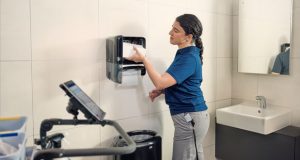Since the coronavirus crisis began in the UK a few months ago, the nation has significantly changed its ways to avoid the illness. With hand hygiene remaining the first line of defence against COVID-19, Trudi Osborne, Marketing Manager at Airdri, sets out the most robust hand hygiene practice, debunking some myths along the way.
The last few months have been challenging to say the least. COVID-19 has affected everyone across the country in some way. From the heroes working on the frontline, to families, friends and businesses that have had to transform their usual way of living and working to protect themselves and others.
As the coronavirus pandemic continues to shake our nation, the reality of the situation is sobering. There is a wealth of information out there, from official government guidelines, to support and advice from respected organisations like the World Health Organisation. However, there has also been an onslaught of poorly researched, sensationalised stories that, sadly, do nothing more than instil fear.
It’s already an unprecedented time, with many people extremely concerned about their health and hygiene. And while it has been fantastic to see often ignored industries, like the cleaning and hygiene sector, finally getting some recognition for the vital role they play in society, it has been less inspiring to witness the consistent attempts to discredit others, like the hand drying sector.
Sensational headlines and stories claiming that hand dryers could spread coronavirus are simply inaccurate. In fact, the Centres for Disease Control and Prevention (CDC) recently advised that “we have no evidence that hand dryers are spreading the coronavirus” and the World Health Organisation has confirmed that once hands are cleaned, they should be dried thoroughly using a paper towel or warm air hand dryer.
But this factual information didn’t seem to stop the unsubstantiated propaganda, so we decided to seek our own expert advice. In recent weeks, we commissioned a leading independent microbiologist to look into the claims in more detail. The resulting report by Dr. David L. Webber has confirmed that the use of hand dryers in the washroom does not contribute to the spread of the novel coronavirus.
Citing various articles and reports into the spread of microbial contaminants, Dr. Webber confirmed that COVID-19 is spread by droplet transmission and contact with contaminated surfaces, but that the risk of contracting the disease should be no greater in the washroom than in any other communal space.
Dr. Webber’s research found that droplet transmission of coronavirus in the washroom was unlikely as the air is constantly changed, typically 8 to 12 times per hour, removing droplets. The use of ‘air purifiers’ in smaller washrooms were also found to remove microbial contaminants, concluding that the risk of infection is probably greater in the general workspace where coughing and sneezing can release airborne bacteria which can survive up to 15 minutes in droplets and aerosols in the air.
The report also referenced the ongoing debate around the most hygienic hand drying process. The findings showed that despite claims made by paper towel manufacturers to suggest that hand dryers contribute to the spread of viruses in the washroom, the reality is that both paper towels and warm air hand dryers offer a hygienic way to dry hands.
Dr.Webber stated: “In a small washroom, a single operation of a typical hand dryer would only disturb 2% to 3% of the volume in the air and is unlikely to contribute to the spread of microbes.”
The report concludes that the most effective way to reduce the risk of infection in the washroom is to wash and dry hands effectively, using soap and hot water and either paper towels or a hand dryer, backing up the advice issued by the World Health Organisation to tackle COVID-19.
Outlining the most robust approach to handwashing during the COVID-19 crisis and beyond, Dr.Webber suggests a four-step process, including:
1. Ensure hands are correctly washed for at least 20 seconds
2. Dry hands thoroughly (10 seconds of drying with a paper towel or jet air dryer, or up to 40 seconds using a warm air hand dryer),
3. Do not touch any surfaces after drying hands, and if you do,
4. Use a hand sanitiser when outside the washroom.
At Airdri, we believe that, at times like this, we should all pull together as an industry and publish responsible, honest information that supports our nation at a time of real distress.
Official advice should continue to be followed. We will keep doing so and support our customers, and the wider public, by providing the most factually correct information that hopefully gives them some comfort around their health and hygiene.

For further advice on hand hygiene tips visit www.airdri.com





